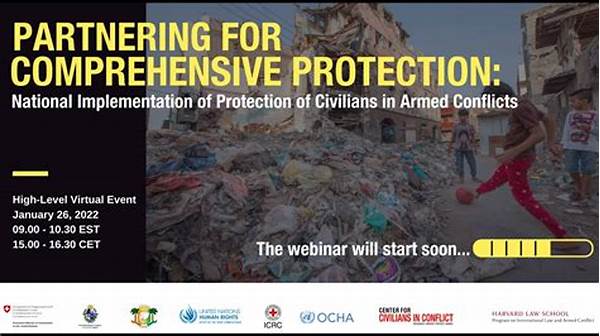Ensuring the safety and dignity of civilians during armed conflicts is a critical concern for the international community. The objective of civilian protection in conflict zones is to alleviate human suffering and maintain human rights standards. This endeavor involves a multidisciplinary approach, encompassing legal frameworks, humanitarian assistance, and peacekeeping operations, all of which aim to minimize the exposure of civilians to risks posed by military engagements.
Legal Frameworks and Civilian Protection
The fundamental principle of civilian protection in conflict zones is enshrined in international humanitarian law, particularly in the Geneva Conventions and their Additional Protocols. These legal instruments mandate the distinction between combatants and non-combatants and prohibit attacks targeting civilians. Furthermore, they call for the establishment of safe zones and the provision of aid to those displaced by conflict. However, enforcement remains a challenge, as compliance is largely dependent on the willingness of state and non-state actors to adhere to these norms. As conflicts evolve, the need for robust legal frameworks that address modern warfare, including cyber warfare and the use of drones, becomes increasingly important to ensure civilian protection in conflict zones.
Challenges in Civilian Protection
1. Complexity of Conflicts: Civilian protection in conflict zones is hindered by the ever-evolving nature of modern conflicts, often characterized by multiple factions and asymmetric warfare.
2. Access Restrictions: Humanitarian agencies frequently face barriers to accessing conflict zones, limiting their ability to provide essential services and ensuring civilian protection.
3. Lack of Compliance: Despite international laws, many conflict parties fail to comply, placing civilians at significant risk.
4. Resource Constraints: The resources available for civilian protection in conflict zones are often inadequate, impeding the effective implementation of protective measures.
5. Political Will: The success of civilian protection initiatives is contingent on the political will of national and international actors to prioritize human rights and peacekeeping efforts.
Humanitarian Assistance and Civilian Safety
Humanitarian organizations play a pivotal role in civilian protection in conflict zones by delivering essential services such as medical care, food, and shelter. Collaborating with local communities, these entities strive to establish secure environments and facilitate the movement of vulnerable populations out of harm’s way. However, the daunting circumstances in conflict zones often create significant obstacles. Logistical challenges, security threats, and insufficient funding frequently hamper the ability of humanitarian agencies to fulfill their mandate. Despite these adversities, the dedication of such organizations remains instrumental in mitigating the adverse effects of conflict on civilians, underscoring the necessity for continued international support and cooperation.
The Role of Peacekeeping Forces
Peacekeeping operations are integral to the framework of civilian protection in conflict zones. These missions, usually sanctioned by the United Nations, aim to stabilize post-conflict regions, support the implementation of peace agreements, and assist in the disarmament and demobilization processes. By maintaining a presence in volatile areas, peacekeepers can deter violence and facilitate the safe return of displaced populations. Moreover, peacekeeping forces contribute to the reconstruction of war-torn societies by supporting capacity-building initiatives and promoting the rule of law. Nevertheless, peacekeeping missions are often constrained by limited resources, restrictive mandates, and the complexity of ongoing conflicts, posing significant challenges to their effectiveness in safeguarding civilians.
Community Engagement in Civilian Protection
Community engagement is a crucial aspect of civilian protection in conflict zones. Local populations possess invaluable knowledge and insights into their environments, which can inform risk assessments and emergency response strategies. By involving community leaders and members in the planning and execution of protective measures, initiatives become more culturally relevant and sustainable. Educational programs designed to raise awareness about safety practices and conflict resolution further empower civilians, allowing them to adopt proactive measures in safeguarding their communities. Such grassroots involvement not only enhances the efficacy of protection efforts but also cultivates resilience among affected populations, thereby reducing vulnerability to future threats.
Technological Innovations and Civilian Safety
In recent years, technological advancements have revolutionized approaches to civilian protection in conflict zones. Digital platforms, satellite imagery, and drones are being harnessed to monitor conflict dynamics and disseminate information quickly to at-risk populations. These tools provide real-time data that can optimize humanitarian responses and facilitate the identification of safe evacuation routes. Moreover, mobile applications enable displaced individuals to access vital resources and connect with aid providers, bridging communication gaps in crisis situations. However, the integration of technology poses ethical and logistical challenges, such as ensuring data security and navigating infrastructural limitations. Despite these hurdles, technology holds significant promise in enhancing the protection of civilians amid conflicts.
Conclusion on Civilian Protection Efforts
In summary, civilian protection in conflict zones is an imperative that requires concerted efforts from various sectors of society. Legal frameworks, humanitarian initiatives, peacekeeping missions, community involvement, and technological innovations collectively shape the strategies employed to safeguard civilians from the ravages of war. The complex and dynamic nature of modern conflicts necessitates adaptive approaches that prioritize human rights and the dignity of affected populations. While challenges persist, the commitment to civilian protection in conflict zones remains unwavering, reflecting the international community’s dedication to alleviating human suffering and fostering a more peaceful world. Through sustained collaboration and innovation, progress towards more effective civilian protection measures can be achieved, offering hope for those caught in the crossfire.





